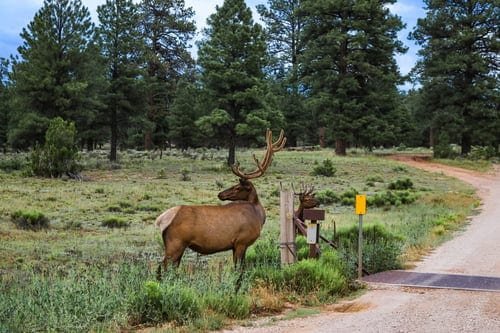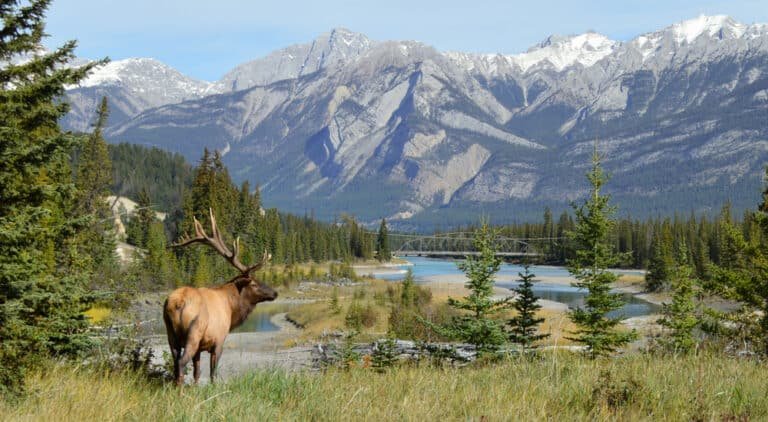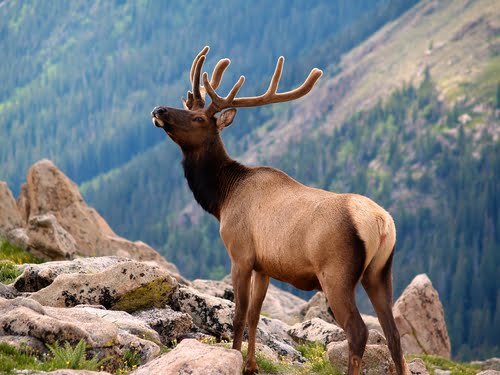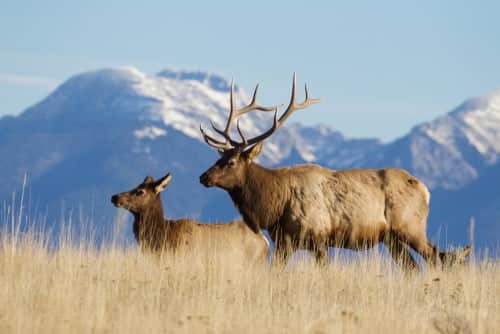Stalking Techniques for Elk Hunting – Don’t Make These Mistakes
Elk hunting is not merely a recreational pursuit but an exhilarating and challenging outdoor activity that has captivated the hearts of hunters for centuries. It combines the thrill of being in the wilderness with the pursuit of one of North America’s most majestic creatures.
The allure of elk hunting lies in its unique blend of physical endurance, mental acuity, and strategic prowess. As hunters embark on this adventure, they are immersed in nature’s grandeur, navigating rugged terrain and embracing uncertainty in pursuit of a coveted trophy.
Elk hunting has become popular due to its inherent challenges and rewards. Elk, unlike many other game species, possess remarkable senses that make them elusive prey.
They have acute eyesight capable of detecting movement from afar, remarkable hearing that can pick up even the faintest rustle, and an extraordinary sense of smell that allows them to detect human presence from great distances. This trifecta poses formidable challenges for hunters seeking to close the gap between themselves and their quarry.
To overcome these challenges, hunters need to master effective stalking techniques. Stalking refers to the artful approach employed by hunters to get within range for a clean shot without alerting or alarming the Elk.
It requires a deep understanding of elk behavior, impeccable stealth skills, patience, and adaptability to ever-changing circumstances. The significance of mastering stalking techniques cannot be overstated for successful elk hunting.
Without skilled stalking abilities, even seasoned hunters may be frustrated by countless failed attempts as their targets effortlessly evade detection or slip away into dense cover before they can line up a clear shot. Effective stalking techniques provide aspiring hunters with a competitive edge by improving their chances of locating and closing in on these magnificent creatures.
In subsequent sections, we will delve deeper into understanding elk behavior – including habitat preferences, social structure, and communication patterns – and explore the essential preparations for a productive hunt. We will then intricately examine various stalking techniques, from glassing and wind direction considerations to stealthy movement and utilizing natural cover.
We will explore advanced strategies such as ambush hunting and calling techniques that can elevate one’s elk hunting experience to new heights. So, strap on your boots, ready your gear, and let us embark on this thrilling journey into the world of stalking techniques for elk hunting.
Understanding Elk Behavior
Elk Habitat Preferences and Seasonal Movements
Elk, majestic creatures of the wild, are highly adaptable and can be found in various habitats throughout North America. However, understanding their habitat preferences is crucial for successful elk hunting. Elk are typically found in mountainous regions, favoring areas with a mix of coniferous forests, aspen groves, meadows, and shrublands.
They seek areas with ample food sources like grasses, forbs, shrubs, and browse. During different seasons, Elk exhibit specific movements to meet their diverse needs.
In the spring and early summer months (May-June), they migrate to higher elevations to access nutritious new vegetation. During this period, known as the calving season, pregnant cows search for secluded areas to give birth to their calves.
As summer progresses into fall (August-October), Elk moves towards lower elevations in search of more abundant food sources and to avoid harsh winter conditions at higher altitudes. This time coincides with the breeding season or rut when bull elk become more vocal and compete fiercely for mating rights.
Social Structure and Communication Among Elk Herds
Elk are social animals that form intricate hierarchical structures known as herds or harems. The structure is primarily based on age and dominance levels among individuals.
A herd is typically led by an older dominant bull known as the herd bull. Within a herd, cows congregate with their calves while bachelor groups form among younger bulls.
During the breeding season or rut, dominant bulls gather a group of receptive cows into their harems through displays of aggression towards competing males. Communication plays a vital role in regulating social interactions among elk herds.
Bulls use bugling calls to advertise their presence while asserting dominance over other males during the rut. Cows emit soft mews to communicate with their calves and maintain contact within the herd.
Feeding Patterns and Preferred Grazing Areas
Elk are herbivores with a diverse diet, enabling them to adapt to different environments. While their primary food source is grasses and forbs found in meadows and open areas, Elk feed on browse (young shoots and leaves) from shrubs and trees. They exhibit a selective feeding pattern, consuming different plant species based on availability, quality, and nutrient content.
Elk prefer grazing in areas where fresh new grasses emerge after the snowmelt or following fires that promote vegetation growth. They often create well-defined trails called game trails, frequently traveling the same routes between feeding, bedding, and watering areas.
Understanding elk behavior about habitat preferences, seasonal movements, social structure, and feeding patterns is crucial for hunters aiming to stalk these elusive creatures successfully. By studying these aspects comprehensively, hunters can increase their chances of locating elk herds and strategizing effective stalking techniques during their hunting expeditions.
Note: Avoid HTML tags when submitting your work for publication or copy-pasting it into a text editor. HTML tags are used here for instructional purposes within this context.
Preparing for the Hunt
Researching the hunting area to identify elk populations and their habits
Before embarking on an elk hunting expedition, it is crucial to invest time and effort into researching the specific hunting area. Understanding the elk populations and their habits will significantly increase your chances of a successful hunt. Begin by studying maps, topographical features, and any available information about previous hunting seasons in the region.
Identify areas known for high elk densities or where herds migrate during different seasons. To delve deeper into this research, consult with local wildlife agencies or experienced hunters from the area.
They can provide valuable insights into popular feeding grounds, watering holes, bedding areas, and travel routes frequented by elk herds. Additionally, scouting trips before the hunt can help familiarize yourself with potential hotspots where you will likely encounter Elk.
Acquiring appropriate gear, including camouflage clothing, scent control products, and binoculars/rangefinders
Equipping yourself with suitable gear is essential for a successful elk hunt. Camouflage clothing that matches your surroundings will blend seamlessly with the environment and reduce your visibility to keen-eyed elks. Opt for patterns that mimic the terrain you will be hunting in – dense forests or open meadows.
In addition to camouflage clothing, investing in scent control products is crucial since elks possess a powerful sense of smell. Scent eliminators such as soaps, shampoos, and detergents help reduce the human odor that could alarm elks when they are nearby.
Furthermore, using cover scents derived from natural elements like pine or earth can help mask human odors effectively. Binoculars and rangefinders are indispensable tools that allow hunters to scout distant landscapes while accurately estimating distances.
High-quality optics enhance your ability to spot elks grazing far away or hidden in plain sight. A rangefinder becomes particularly handy when determining the distance between you and your target, ensuring precise shots.
Physical fitness training to ensure endurance during long stalks
Elk hunting often demands considerable physical exertion due to the vast, rugged terrains where these majestic creatures dwell. To maximize your chances of success and endure long stalks, engaging in a dedicated physical fitness training regimen is imperative.
Focus on building cardiovascular endurance as well as muscle strength and flexibility. Incorporating jogging or cycling into your routine will enhance stamina and improve lung capacity.
Additionally, exercises targeting leg muscles (such as squats or lunges) are essential for traversing uneven terrain. To simulate real hunting conditions, practicing hiking with a loaded backpack similar to what you will carry during the hunt is recommended.
This will help condition your body for the added weight and improve overall endurance. Remember that elk hunting can require hours of stalking, often over challenging landscapes, so being physically prepared is crucial for optimal performance in the field.
By thoroughly researching the hunting area, acquiring appropriate gear tailored to elk hunting needs, and investing time and effort into physical fitness training, hunters can significantly increase their chances of success when stalking elusive elk populations. These preparations lay a solid foundation for the upcoming challenges in pursuing this magnificent game species.
Stalking Techniques for Elk Hunting
Glassing: Utilizing binoculars or spotting scopes to scan open areas from a distance, identifying potential targets and evaluating their behavior.
Glassing is an essential skill for elk hunters, allowing them to observe the terrain and elks’ behavior from afar. The first step is to find a vantage point that provides a wide field of view over open areas, meadows, or forest clearings where elks are likely present. Once settled in a comfortable position, slowly scan the landscape using binoculars or spotting scopes.
When glassing for Elk, it is crucial to be patient and meticulous. Pay attention to any movement – elks grazing, bedding down, or interacting with each other.
Look for distinguishing features such as antlers or body size to determine if the observed Elk fits your hunting criteria. By observing their behavior and movements, you can better predict their route and plan your stalking approach accordingly.
Wind Direction: Understanding the importance of wind direction to remain undetected by an elk’s keen sense of smell.
The sense of smell possessed by elks is highly refined and plays a major role in their survival instincts. To avoid detection during stalking, it’s crucial to understand the significance of wind direction. Always ensure you are upwind from your target so your scent doesn’t carry towards them.
Before beginning your stalk, analyze the prevailing wind patterns in your hunting area. Tools such as weather apps can provide wind speed and direction information ahead of time.
During the hunt, use lightweight wind indicators like powder puffers or tufts of grass suspended on strings tied to your gear. Continually reassess wind direction as you move closer toward your prey.
Remember that constantly adjusting your position based on shifting winds will significantly increase your chances of remaining undetectable. By keeping the wind in your favor, you minimize the risk of your scent alerting the elks to your presence.
Stealthy Movement: Tips on moving silently through various terrains (e.g., forests, meadows) while minimizing noise from gear or footsteps.
When stalking Elk, moving silently and minimizing noise is imperative to avoid alarming them. Proper footwear can make a significant difference; opt for lightweight boots with a good grip and quiet soles that won’t crunch loudly on leaves or twigs.
Move deliberately and cautiously, taking small steps with controlled weight distribution. Roll your feet from heel to toe instead of lifting them off abruptly.
Utilize available cover, such as fallen trees or rocks, to break up your silhouette and mask any movement. Moreover, be mindful of clothing choices that won’t produce rustling sounds when brushing against vegetation.
Avoid wearing loose accessories like bracelets or keychains that might jingle as you walk. The ability to move stealthily through different terrains is an art honed through practice and experience – it allows you to get closer undetected.
Using Natural Cover: Exploiting natural features like trees, rocks, or terrain irregularities to stay hidden while closing the distance between hunter and prey.
One of the key aspects of successful elk stalking is utilizing natural cover effectively. This involves using trees, rocks, bushes, or any available terrain irregularities that can provide concealment during the approach. As you close in on your target elk herd, take advantage of topographical features such as gullies or ridges that offer natural concealment for movement.
Crawl when necessary and keep low behind obstacles as much as possible without giving away your position. Blending into the surroundings and avoiding sudden movements that may catch an elk’s attention increases the likelihood of staying hidden until within range for a successful shot.
Mimicking Elk Calls: Techniques for using bugle calls or cow calls effectively to attract Elk or divert their attention away from the hunter’s presence.
Mimicking elk calls is an advanced technique that can enhance your chances of success during stalking. By imitating elk vocalizations, hunters can lure elks closer or divert their attention, creating favorable opportunities for a successful stalk. Bugle and cow calls are the two primary elk vocalizations hunters use.
The bugle call imitates a bull elk’s mating call and can attract both bulls and cows. Conversely, cow calls mimic the sounds made by female elks to communicate with other herd members.
Mastering these techniques requires practice and familiarity with different call variations and corresponding scenarios. Timing, pitch, duration, and intensity are critical in generating realistic calls that can effectively deceive elks.
When using these vocalizations, it’s crucial to remain patient and evaluate the reaction of the targeted elk herd. Adjust your calling strategy accordingly to maximize its effectiveness while ensuring you maintain stealth in your approach.
By incorporating these stalking techniques into your elk hunting repertoire, you increase your chances of success while engaging in this challenging pursuit. Remember that practice, patience, and respect for nature are crucial in becoming a skilled stalker capable of outwitting elusive elks.
Advanced Stalking Strategies
Ambush Hunting: The Art of Strategic Positioning
When it comes to stalking Elk, one advanced technique that seasoned hunters swear by is ambush hunting. This method involves setting up strategic locations based on a deep understanding of elk behavior and habitat. By carefully studying their travel routes, bedding areas, and feeding grounds, hunters can increase their chances of intercepting these majestic creatures.
Seasoned hunters know that successful ambush hunting requires patience, often involving waiting for hours or even days in a concealed spot. However, the rewards can be tremendous when an unsuspecting elk wanders into range.
Calling Strategies: Mastering the Language of Elk
Elk are highly vocal creatures known for their distinct bugles and cow calls. Mastering various calling strategies can significantly enhance your stalking success. Bugle calls are primarily used during the rutting season to imitate a dominant bull’s call, attracting other bulls to challenge or drawing curious cows closer.
On the other hand, cow calls aim to mimic the sounds made by female Elk to lure in bulls seeking mates or gather cows together. Hunters must practice these calls diligently using diaphragm calls or external bugle tubes for optimum authenticity and effectiveness.
Conclusion
As we conclude this exploration into advanced stalking strategies for elk hunting, one cannot help but feel exhilarated by the immense possibilities that await determined hunters who master these techniques. Ambush hunting allows you to become one with nature as you patiently await your quarry while blending seamlessly into the environment. Effective calling strategies transport you into the heart of an elk herd’s social dynamics – speaking their language with finesse and precision.
The knowledge gained through understanding these methods elevates your chances of success and deepens your connection with nature. So take this knowledge immediately on your next elk hunting expedition, armed with the skills of an ambush hunter and the eloquence of an elk whisperer.
May your stalking endeavors be rewarding, filled with awe-inspiring encounters and unforgettable moments in the untamed wilderness. Happy hunting!







reputable mexican pharmacies online
http://cmqpharma.com/# medication from mexico pharmacy
mexican online pharmacies prescription drugs
You have observed very interesting points! ps nice
internet site.Raise your business
top 10 online pharmacy in india п»їlegitimate online pharmacies india Online medicine order
https://foruspharma.com/# purple pharmacy mexico price list
top 10 online pharmacy in india: best online pharmacy india – reputable indian online pharmacy
mexican border pharmacies shipping to usa: medicine in mexico pharmacies – mexican pharmacy
canadian pharmacy india canada rx pharmacy world canadian pharmacy meds review
pharmacy canadian superstore: online canadian pharmacy reviews – canadian pharmacy victoza
top online pharmacy india: buy medicines online in india – top 10 pharmacies in india
https://foruspharma.com/# п»їbest mexican online pharmacies
my canadian pharmacy review www canadianonlinepharmacy best rated canadian pharmacy
mexico pharmacies prescription drugs: buying from online mexican pharmacy – mexican mail order pharmacies
purple pharmacy mexico price list: mexican pharmacy – п»їbest mexican online pharmacies
canada drugs canadianpharmacyworld canadian pharmacy oxycodone
mexico drug stores pharmacies: medicine in mexico pharmacies – mexican border pharmacies shipping to usa
https://indiapharmast.com/# india pharmacy
best online pharmacies in mexico: purple pharmacy mexico price list – mexico pharmacies prescription drugs
buy prescription drugs from india: buy prescription drugs from india – india pharmacy
http://paxloviddelivery.pro/# paxlovid generic
https://doxycyclinedelivery.pro/# order doxycycline
https://paxloviddelivery.pro/# paxlovid pharmacy
http://amoxildelivery.pro/# can i buy amoxicillin over the counter in australia
https://clomiddelivery.pro/# can i buy clomid for sale
https://doxycyclinedelivery.pro/# buy doxycycline 100mg online usa
http://paxloviddelivery.pro/# paxlovid pharmacy
http://ciprodelivery.pro/# ciprofloxacin generic
http://ciprodelivery.pro/# п»їcipro generic